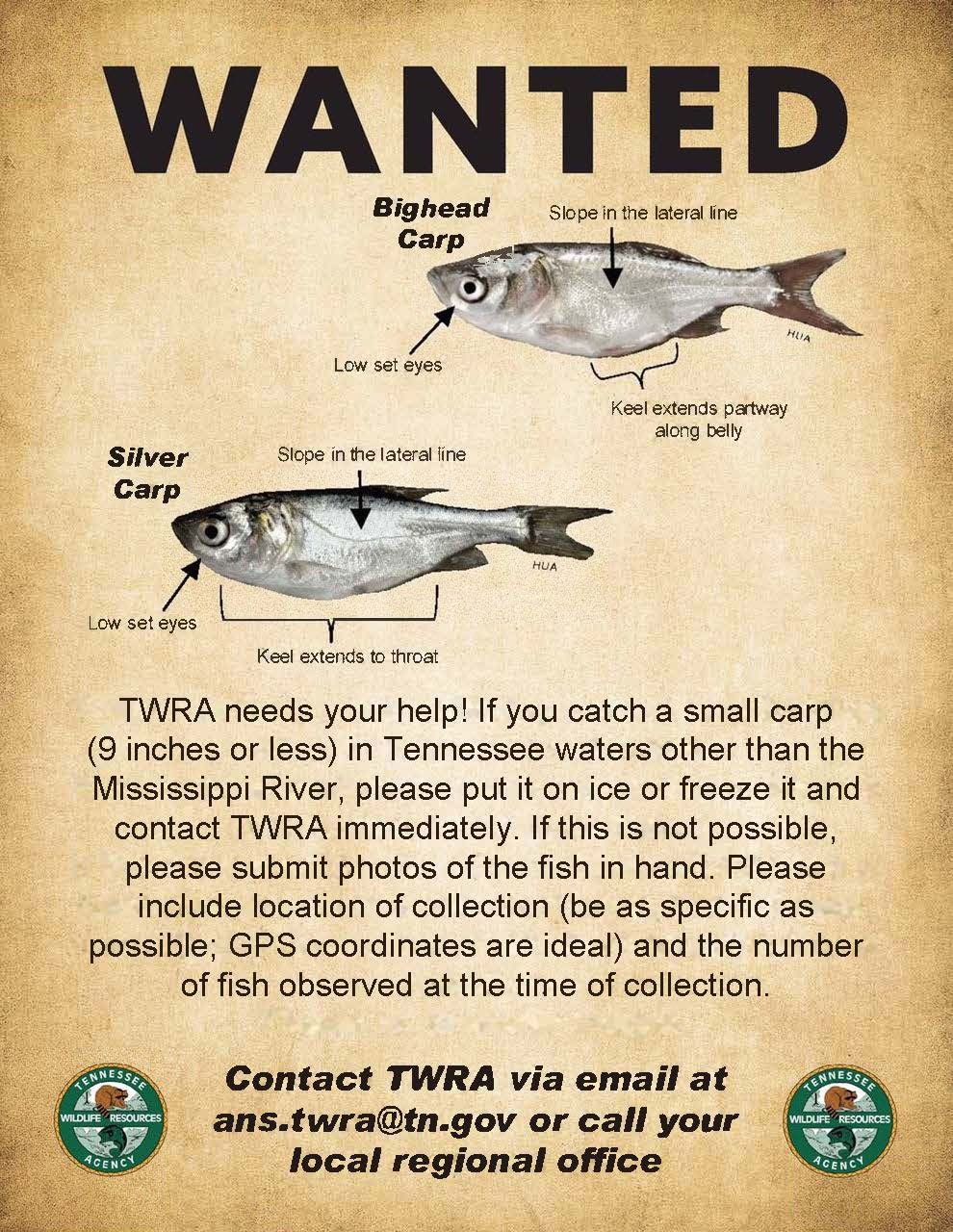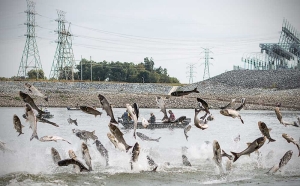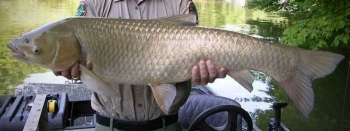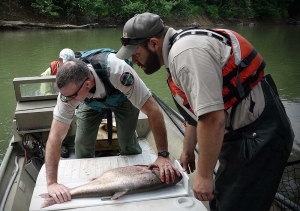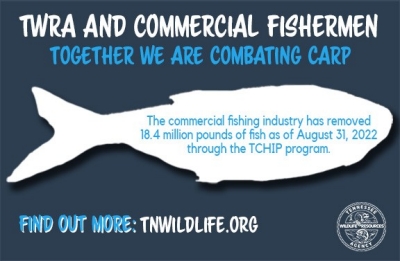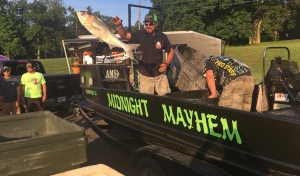Invasive Carp
The TWRA needs your help in collecting invasive carp
If you catch an invasive carp anywhere in Tennessee other than the Mississippi River OR If you catch any invasive carp in East Tennessee or other water where invasive carp are not known to be established, the agency is asking that you put it on ice or freeze it and contact them immediately.
If you are unable to keep the fish, the TWRA asks you to take photos of the fish and send the image to us including information on location of capture. You can contact the nearest TWRA office by phone here, or by email at ans.twra@tn.gov.
Known distribution of Silver Carp in Tennessee
Invasive Carp in Tennessee and Management Efforts
There are four species of invasive carp in the United States and in Tennessee. All are from the Yangtze and Amur River systems in China.
They were imported into the United States for various aquaculture purposes back as early as 1970. They were unintentionally introduced into the waters of our country in the late 1980s and early 1990s when they escaped from aquaculture ponds in the delta areas of the Mississippi River during extreme floods.
All four invasive carp species were first found in the Mississippi River, where they are still abundant, and they migrated into Tennessee waters via locks at Kentucky and Barkley dams. Carp are also known to have entered Reelfoot Lake during high flows through its spillway.
All four invasive carp species can affect fish and aquatic life in numerous ways.
Bighead Carp
This species of invasive carp consume microscopic zooplankton. Zooplankton is an important part of the diet for many native fish such as Shad, Buffalo, and Paddlefish. Larval sport fish such as Crappie, Bass, and Bluegill also depend upon zooplankton in their early life stage.
Bighead Carp are problematic because they compete with our native species of fish for food and space. Bighead Carp can grow as large as 100 pounds.
This species is thought to be most abundant in the lower reservoirs of the Tennessee and Cumberland rivers, but a few individuals have been observed as far upstream as Nickajack Reservoir.

Silver Carp
This species of invasive carp eats microscopic algae and zooplankton. They are problematic for the same reasons as mentioned for the Bighead Carp. They compete for food and space with our native species.
In addition, when Silver Carps are startled they have a tendency to leap out of the water and can jump as high as eight feet. Therefore, they are even more problematic because of the potential to injure boaters and recreators.
Silver Carp can grow as large as 60 pounds.
In the Tennessee River, Silver Carp are most abundant in Kentucky Reservoir, with an emerging population in Pickwick Reservoir as well. The most upstream report of Silver Carp on the Tennessee River was a fish leaping into the boat of an angler on Chickamauga Reservoir in October 2019. On the Cumberland River, they have been observed as far upstream as Cordell Hull Dam.
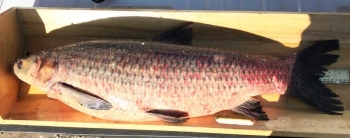
Black Carp
This species of invasive carp eats snails and mussels. It was brought into the U.S. to control snails in commercial catfish ponds. Snails serve as a host for parasitic worms that get into fish flesh thus making catfish meat unappealing. Eliminating the snails eliminates the parasitic worms.
Black Carp are problematic because they could eat the many species of snails and mussels that are native to Tennessee.
A 70-pound Black Carp was caught by a commercial fisherman in the mouth of the Obion River on the Mississippi River in 2012. Until recently Black Carp had only been reported in the Mississippi River. Since 2017 there have been a few documented catches of Black Carp in Barkley and Kentucky reservoirs.
Grass Carp
Grass Carp, also known as White Amur, eat aquatic vegetation. This species was introduced into the U.S. to control excess aquatic vegetation (weeds) in commercial catfish ponds.
Grass Carp are a concern because they eat many types of aquatic vegetation and much of this vegetation provides excellent cover for a variety of sportfish such as Largemouth Bass, Crappie, and Bluegill. Many species of aquatic vegetation also provide food for waterfowl.
Reproductively sterile Grass Carp are commonly used to manage aquatic vegetation in small lakes and are legal to stock in private lakes and ponds as long as they are sterile (triploid). Grass Carp can reach sizes in excess of 80 pounds.
Grass Carp are increasingly a cause of concern because recent testing of Grass Carp in wild populations has revealed that many of these fish are not the sterile variety, and so they can and likely have been reproducing when they get the right conditions.
Why is the Tennessee Wildlife Resources Agency Concerned About Carp?
The most immediate concern is for the safety of boaters. Silver Carp are known to jump when disturbed by boats. A jumping carp that collides with a passenger in a moving boat can cause serious injury. This scenario is most common in shallower waters and boaters should slowly retreat from areas with jumping carp to avoid impact.
Invasive carp have the capacity to deplete and alter the current food web of the reservoirs that support natural resources, including highly-valued recreational and commercial fisheries. Silver and Bighead Carp are both filter feeders that feed on microscopic plankton. This plankton is a vital food for some species of fish, and young fish of all species. By out-competing native fish for a limited resource, the Silver and Bighead Carp have the ability to reduce the growth rates of native fish or displace them almost completely. The Black Carp pose a risk to Tennessee’s diverse and already threatened mussel fauna.
While there is still much concern about large schools of carp in Kentucky and Barkley reservoirs, TWRA biologists report that the abundance of native fish (crappie, shad, bass, etc) are still within the normal range of natural fluctuations. In addition, when a large school of invasive carp moves into an area, they will displace many of the native species in that area. Although the native fish will return when the invasive carp move from the area, fishing patterns will be disrupted while the invasive carp are present.
Invasive Carp Management is a National Effort
Invasive carp are a national problem and control of carp is a national effort. Tennessee representatives actively serve as partners in multiple sub-basins in the Mississippi River where they work collaboratively with other state representatives, the U.S. Fish and Wildlife Service, Tennessee Valley Authority, and the U.S. Army Corps of Engineers in those basins to make the best use of the limited federal dollars that are available for carp control. Tennessee is also an active participant in the Mississippi River Interstate Cooperative Resource Association, an organization of 28 states and federal agencies that are working together to lobby for additional carp management funds. Find out more... http://www.asiancarp.us
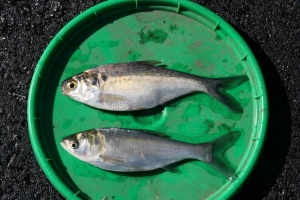
Controlling the Spread of Invasive Carp in Tennessee
It is illegal to move live carp in Tennessee.
TWRA continues to spread the message about carp to reduce the likelihood that someone will accidentally move them as bait. TWRA annually cautions against bait bucket introductions in the annual fishing regulations, “The Angler’s Guide to Tennessee Fish” publication, through lake-side signs, fishing shows, and other presentations annually.
Unchecked, invasive carp will eventually use the navigation locks on Tennessee and Cumberland rivers to spread their range upstream. Each time a lock opens and closes fish have an opportunity to move up and down the river.
TWRA and partners identified a need to conduct research on carp movement, especially as it related to lock passage. As a result, TWRA received funding to evaluate the movement of carp in the Tennessee River, including the Mississippi and Alabama sections. This research effort led by Tennessee Tech University started in late 2016, has evolved over time and is ongoing. Over 1,000 carp are tagged with sonic transmitters, and they are being tracked throughout the river system by passive receivers. This research will tell us how and when the carp are using areas of the reservoirs, and it will also be used to evaluate newly-developed technology that could create barriers at locks.

Removal of Invasive Carp
In areas where invasive carp are already established, there is still a need to reduce their numbers. This will reduce their threat to boaters and aquatic resources.
Carp removal is also strategic to controlling the spread of carp because upstream movement is less likely if the population in the current reservoir is not too high. These mechanisms are not fully understood but to be on the safe side TWRA is encouraging carp harvest.
While more high-tech solutions may eventually be developed, commercial fishing is presently the most practical method to reduce the abundance of invasive carp in Tennessee waters. The industry was slow to respond to the market possibilities, but the abundance of invasive carp has now attracted private industry into purchasing and processing invasive carp for consumer use.
Commercial fishing has the ability to remove millions of pounds of carp annually. At the recommendation of the Tennessee General Assembly’s Asian Carp Task Force, TWRA funded a $75,000 grant in 2017 to the Paris Henry County Industrial Committee to develop local commercial fishing businesses for carp.
Also, in 2020 TWRA provide a $400,000 grant for wholesale fish dealers enrolled in the Asian Carp Harvest Incentive Program (ACHIP). As a result recipient businesses have increased their interest in the harvest of invasive carp.
Monitoring Carp
TWRA has been intensively monitoring carp for several years. In the early days of their invasion, TWRA first collected invasive carp in the Mississippi River. Later, fisheries staff were responding to sporadic calls about carp in Kentucky Reservoir and Reelfoot Lakes, but in the past five years TWRA Region 1 Fisheries staff have incorporated carp monitoring in their routine samples multiple times each year. Monitoring carp abundance is also an important component of TWRA supported research at TTU. It is critical that we have repeatable methods to monitor the carp abundance so that we can evaluate the success of control and removal strategies.
Carp Spawning
In 2015 invasive carp had a successful spawn somewhere in the Ohio/Tenn/Cumberland system. Details about the production of this cohort are not known. Since 2016 TWRA has been intensively monitoring Kentucky and Barkley reservoirs to determine when and where they are spawning. Such information could prove useful in carp removal efforts. Monitoring efforts include larval trawls, light traps, mini-fyke nets, dozer trawls, and electrofishing occurring from April-Oct. No evidence of successful spawning within the Tennessee or Cumberland rivers has been observed since this monitoring began. Rather, the majority of the fish are suspected to be migrants from the Ohio River.
Sound Barriers for Carp at Locks
Invasive carp are extremely sensitive to sound. Researchers at the U.S. Geological Survey and U.S. Fish and Wildlife Service have developed techniques to use underwater sound to “scare” fish in controlled settings.
In concept, these sounds would be able to prevent carp from using the locks, while native fish that are less sensitive to sound would continue to use the locks. The next step is to test this theory and that test has begun at Barkley Dam on the Cumberland River in Kentucky with the implementation of the BioAcoustic Fish Fence (BAFF).
Multiple state agencies including TWRA support this effort. This location was chosen because carp are abundant immediately below the dam, so the barrier would be tested repeatedly by the abundant carp. The sonic tagging and tracking work that TWRA is funding will allow this technology to be deployed and evaluated at strategic locations throughout the Tennessee River as well.
Native Fish
TWRA annually monitors the status of gamefish species such as bass and crappie.
They also monitor the abundance of their prey species - gizzard and threadfin shad. In addition to these ongoing efforts, they are also monitoring the condition of gizzard shad to see if they are being impacted by carp. Gizzard shad are thought to be a good indicator species because their diet most directly overlaps with silver and bighead carp. This data will allow biologists to determine the impacts of Invasive carp on population densities and the condition of both important prey and game species.
The agency will continue to post information about invasive carp and efforts to combat the growth and expansion of these fish into our waters. Please keep informed and help spread the word to help stop the spread of invasive carp in Tennessee’s lakes and rivers.
Tennessee Carp Harvest Incentive Program
On May 18, 2018, the Tennessee Fish and Wildlife Commission (TFWC) approved a $500,000 budget request to provide incentives for the commercial harvest of invasive carp in Kentucky, Barkley, Cheatham, and Old Hickory lakes. From the approved funding by the TFWC, the Tennessee Carp Harvest Incentive Program was implemented on Sept. 18, 2018.
Currently, the TCHIP program has enrolled wholesale fish dealers and commercial fishermen. The program assists wholesale fish dealers and commercial fishermen by providing incentives for the harvest and sale of invasive carp.
As of August 31, 2022, the TCHIP program has provided the necessary funds for the removal of over 18.4 million pounds of carp from the Tennessee and Cumberland rivers.
Bowfishing
TWRA encourages bow fishers and bow fishing tournaments to consider a carp-only format.
For example, on June 23, 2018, TWRA partnered with the KY Department of Fish and Wildlife Resources to host a carp-only bow fishing tournament. During the 12-hour event, 81 boats harvested 17,000 lbs of invasive carp, predominantly Silver Carp.
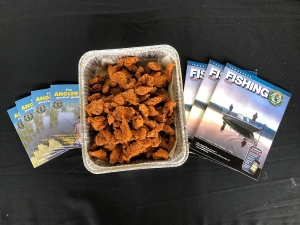
Consuming Invasive Carp
Many potential consumers of invasive carp are wary of eating a fish named “carp” that they know little about. To promote carp as food, TWRA serves invasive carp at a few events each year. If more people appreciated carp for its great taste and texture, the agency believes demand should increase along with the price of harvested carp.
This increased value would generate an additional commercial harvest of carp. TWRA has also been working with product labeling consultants to develop carp label standards that would let the buyer know that purchasing that product will help natural resources.
Silver Carp Educational Video with Bill Dance - Produced in 2005

